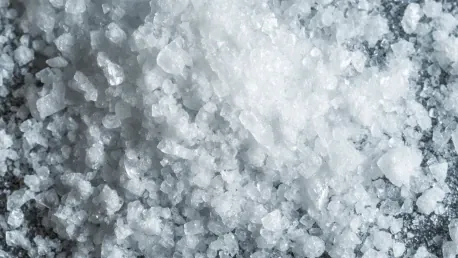The Europe fumed silica market is projected to witness significant growth in the coming decade. Valued at USD 1.57 billion in 2024, the market is expected to reach USD 2.47 billion by 2033. With a compound annual growth rate (CAGR) of 5.16% from 2025 to 2033, this versatile nanomaterial finds extensive applications across several industries such as silicone rubber, plastics, paints, coatings, and pharmaceuticals. The robust growth trajectory highlights the pivotal role key industries play in driving fumed silica’s demand, thanks to its unique properties like thickening, anti-settling, and reinforcing capabilities.
Market Drivers Fueling Growth
One of the key drivers of the Europe fumed silica market is the surging demand for silicone rubber. The automotive, construction, and healthcare sectors are the primary consumers of silicone rubber, which significantly benefits from the incorporation of fumed silica. The European Rubber Manufacturers Association reported a 10% growth in the silicone rubber market in 2022, largely attributed to the inclusion of fumed silica to enhance both mechanical and thermal properties. The European Commission further noted that more than 60% of silicone rubber formulations integrate fumed silica, underscoring its critical role in providing high-performance features.
This growing demand is not only reassuring but also paints a promising picture of sustained growth in the coming years. Companies in the automotive sector, for example, are increasingly incorporating advanced materials to meet stringent efficiency and performance standards. Likewise, in the construction sector, high-performance materials like fumed silica are crucial for developing resilient and durable infrastructure. In the healthcare field, medical devices and equipment benefit from the enhanced properties of silicone rubber, making fumed silica an indispensable additive.
Adoption in Paints and Coatings
Another essential driver of the fumed silica market in Europe is its increasing adoption in the paints and coatings industry. An 8% rise in the demand for high-performance additives was documented by the European Paints and Coatings Association in 2022, driven by growing consumer awareness regarding product durability and aesthetic quality. Fumed silica’s ability to impart properties such as uniform dispersion, improved shelf life, and acting as an anti-settling agent makes it indispensable for formulators seeking to enhance both the visual and structural qualities of paint and coating products.
The paints and coatings sector sees substantial investments in research and development to innovate and meet evolving consumer preferences. As urbanization continues and the real estate sector flourishes, the demand for high-quality paints and coatings is set to rise. Fumed silica’s unique properties allow manufacturers to meet the high standards for durability and appearance, providing an edge in a competitive market. Moreover, the emphasis on sustainability and eco-friendliness in product offerings aligns with fumed silica’s potential to contribute to more environmentally friendly formulations.
Addressing Market Restraints
Despite its growing popularity and demand, the market for fumed silica is not without its challenges. High production costs are a significant restraint, with the production of fumed silica being 30-40% more expensive than traditional fillers. This cost factor makes fumed silica less accessible and affordable for small and medium-sized enterprises (SMEs), thereby limiting its widespread adoption. Furthermore, fluctuations in raw material prices, particularly silicon tetrachloride, exacerbate the cost issue. In 2022, the cost of silicon tetrachloride surged by 25% due to supply chain disruptions, deeply impacting profit margins for producers.
Stricter regulatory standards also pose challenges to the fumed silica market. Compliance with the European Chemicals Agency’s REACH Directive requires exhaustive testing and documentation, adding financial strain particularly for SMEs. The regulatory landscape in Europe is stringent, ensuring that only the highest quality, safest materials are used in industrial applications. While these regulations are in place to protect both the environment and end-users, they also increase the cost and complexity of market entry for smaller players. This dynamic requires a balance between safety, compliance, and market accessibility to encourage broader use of fumed silica.
Opportunities in Sustainable Practices
On the brighter side, significant opportunities arise from the adoption of sustainable manufacturing practices. The European Commission’s Green Deal initiative is prompting more industries to transition to eco-friendly materials, with fumed silica solutions being no exception. Over 30% of industries are now leaning towards organic and recyclable fumed silica solutions, aligning with Europe’s broader commitment to reducing carbon footprints and enhancing sustainability. This demand for sustainable practices opens new avenues for fumed silica producers to innovate and develop eco-friendly products, thus driving market growth.
Europe’s commitment to sustainability manifests in various forms, from innovative recycling initiatives to the development of products with lower environmental impact. Industries are increasingly aware of their carbon footprints and are proactively seeking materials that can help them achieve their sustainability goals. Fumed silica’s versatility and compatibility with eco-friendly manufacturing processes make it an ideal candidate for companies focused on green innovation. The shift towards sustainable and responsible sourcing also garners customer approval, enhancing brand reputation and consumer loyalty.
Expansion into Emerging Applications
Emerging applications in the pharmaceutical and personal care industries present additional promising areas for market expansion. The European Pharmaceutical Manufacturers Association reported a 12% increase in the use of fumed silica in drug formulations in 2022, primarily due to its ability to enhance product flowability and stability. Fumed silica’s role in pharmaceuticals extends beyond mere additive functions, playing a crucial part in ensuring the efficacy and stability of medications, making it highly valued within this sector.
Similarly, the European Cosmetics Association documented a 15% annual rise in the use of fumed silica in skincare and haircare products. As a thickening and stabilizing agent, fumed silica meets the growing consumer demand for eco-friendly and clean-label ingredients. The personal care industry is increasingly leaning towards natural and sustainable products, and fumed silica’s properties align perfectly with this trend. Its ability to improve texture, stability, and overall product performance makes it an attractive ingredient for formulators aiming to meet the high standards of modern consumers.
Overcoming Supply Chain Challenges
Supply chain disruptions are among the critical challenges affecting the fumed silica market. The Russia-Ukraine conflict, for instance, severely impacted the supply of raw materials such as silicon tetrachloride, leading to significant cost hikes and availability issues. These geopolitical tensions have created substantial bottlenecks in the supply chain, emphasizing the need for more resilient and diversified sourcing strategies. Shipping delays, as reported by the European Maritime Safety Agency, compounded these challenges by causing shortages and inflated prices. In 2022, there was a 25% increase in delays, disrupting timely deliveries of essential raw materials.
These supply chain issues necessitate proactive measures from both suppliers and manufacturers to mitigate risks and ensure stable production. Companies are increasingly investing in more robust supply chain infrastructures, exploring alternative sources, and improving inventory management to buffer against such disruptions. Moreover, industries are recognizing the importance of establishing strategic alliances and partnerships to create more resilient supply chains. By addressing these challenges head-on, the fumed silica market can better navigate uncertainties and maintain growth momentum.
Enhancing SME Awareness
Limited awareness among small-scale manufacturers adds another layer of complexity to the market dynamics. Less than 40% of SMEs in Europe utilize fumed silica in their formulations due to a significant knowledge gap and lack of training. This limited utilization stems from insufficient information on the benefits and applications of fumed silica, coupled with the perceived high cost of adoption. Addressing this gap requires coordinated efforts from governments, educational institutions, and industry stakeholders to enhance awareness and provide comprehensive training programs.
Initiatives aimed at improving SME awareness are crucial for fostering innovation and broader market adoption of fumed silica. Workshops, seminars, and industry collaborations can play a significant role in educating smaller manufacturers about the advantages of incorporating fumed silica into their products. Additionally, providing financial incentives or subsidies could alleviate the cost barriers that hinder SMEs from exploring this advanced material. Such efforts will not only drive the market forward but also ensure more inclusive growth, enabling even the smaller players to benefit from the burgeoning fumed silica industry.
Market Segmentation: Type and Application
The European fumed silica market is segmented by type into hydrophilic and hydrophobic variants. Hydrophilic fumed silica, which dominated the market with a 61.6% share in 2024, is widely used as a thickening agent and reinforcing filler across various industries due to its ability to improve product consistency and performance. The European Commission reports that over 70% of hydrophilic fumed silica consumed in Europe is utilized in industrial applications, underlining its importance in enhancing product attributes in sectors like construction, automotive, and pharmaceuticals.
Conversely, the hydrophobic fumed silica segment is anticipated to see a promising CAGR of 9.1% through the forecast period, driven by its superior moisture resistance and flowability. These properties make hydrophobic fumed silica ideal for high-performance applications in silicone rubber, pharmaceuticals, and personal care products, where enhanced moisture resistance and ease of processing are critical. As industries increasingly demand materials that can withstand harsh conditions and maintain their efficacy, hydrophobic fumed silica’s role is set to grow, further diversifying its market presence.
Application-Based Insights
On the application front, the fumed silica market spans multiple industries including silicone rubber, plastics, paints, adhesives, and more. The silicone rubber segment commanded a 35.5% share in the European market in 2024, attributed to its essential role in improving mechanical properties and thermal stability. Industries such as automotive and healthcare rely heavily on the advanced features imparted by fumed silica to silicone rubber, underscoring its importance in maintaining high standards of performance and safety.
The personal care segment is expected to exhibit a robust CAGR of 10.4% in the forecast period, driven by the increasing demand for eco-friendly and clean-label ingredients in skincare and haircare formulations. Consumers are becoming more conscious of the ingredients used in personal care products, leading to a shift towards formulations that prioritize sustainability and natural components. Fumed silica’s ability to enhance product stability, texture, and overall performance aligns perfectly with this trend, making it an attractive ingredient for personal care manufacturers aiming to meet these consumer expectations.
Regional Market Dynamics
Regionally, Germany held a dominant 26.8% share of the European fumed silica market in 2024. This prominence is attributed to Germany’s robust chemical and automotive industries, which together account for over 40% of fumed silica consumption in Europe. Germany’s strategic investments in sustainable materials and advanced manufacturing technologies also align with the European Green Deal initiative, further underpinning market growth. The country’s commitment to innovation and sustainability ensures a steady demand for high-performance additives like fumed silica.
France also reported significant growth, driven by its strong presence in the cosmetics and coatings sectors. The French Ministry of Agriculture has highlighted the growing use of clean-label formulations, enhancing fumed silica adoption in personal care products. Additionally, France’s dynamic research and development landscape, supported by both public and private investments, fosters advancements in material science, paving the way for innovative applications of fumed silica in various industries. The convergence of regulatory support, industry demand, and a favorable innovation ecosystem positions France as a key player in the fumed silica market.
Navigating the Competitive Landscape
The Europe fumed silica market is set to experience substantial growth over the next decade. Currently valued at USD 1.57 billion in 2024, it is anticipated to climb to USD 2.47 billion by 2033. This represents a compound annual growth rate (CAGR) of 5.16% between 2025 and 2033. Fumed silica, a versatile nanomaterial, is extensively utilized across numerous industries, including silicone rubber, plastics, paints, coatings, and pharmaceuticals. Its increasing demand is largely driven by its outstanding properties, such as thickening, anti-settling, and reinforcing capabilities.
Industries reliant on high-performance materials are particularly propelling the demand for fumed silica. For instance, in the silicone rubber industry, fumed silica is crucial for enhancing durability and strength. In the paints and coatings sector, it prevents settling and improves the viscosity of products. The plastics industry benefits from its reinforcing properties, enhancing the quality and performance of plastic products. Additionally, the pharmaceutical industry uses fumed silica for its anti-caking and thickening properties, making it indispensable in drug formulation.
This robust growth trajectory underscores the significant role these key industries play in driving the market forward. With its multifaceted applications and unique properties, fumed silica is poised to become even more integral in the production processes of various sectors, ensuring its rising demand in the years to come.









